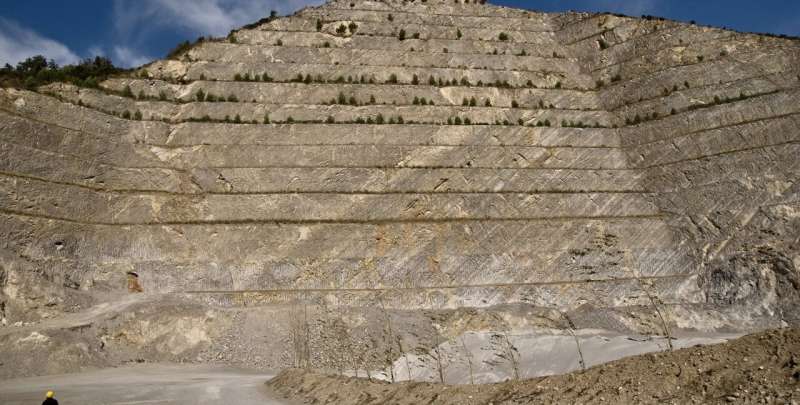This article has been reviewed according to Science X's editorial process and policies. Editors have highlighted the following attributes while ensuring the content's credibility:
fact-checked
peer-reviewed publication
trusted source
proofread
Sediments reveal the ancient ocean during a mass extinction event

About 183 million years ago, volcanic activity in modern South Africa unleashed an estimated 20,500 gigatons of carbon dioxide (CO2) into the ocean–atmosphere system over a period of 300 to 500 thousand years. Known as the Toarcian Oceanic Anoxic Event (T-OAE), the lack of oxygen, or anoxia, in the water during this time caused a mass extinction of marine species.
Human activity since the industrial revolution has already resulted in cumulative CO2 emissions representing 12% of the total CO2 released during the entire T-OAE, in less than 0.1% of the time. The T-OAE foreshadows what might happen to our oceans if greenhouse gas emissions continue to increase.
"You can see lots of fossils within ocean sediments before the T-OAE, and then suddenly they disappear," says Caltech's Francois Tissot, Professor of Geochemistry and Heritage Medical Research Institute Investigator.
Tissot is a co-author on a new study that was published on June 24 in the Proceedings of the National Academy of Sciences, describing the extent of the ocean anoxia during the T-OAE.
Led by researchers from George Mason University, the team collected 30 samples of stratified limestone from the Mercato San Severino region in southern Italy to assess the severity of ocean deoxygenation during the T-OAE.
The team analyzed the samples for their uranium content and isotopic composition. Isotopes are twin version of an element with different number of neutrons, and thus very slightly different masses.
The relative abundance of isotopes of uranium in the ocean depends on the amount of anoxia. This means that by measuring the isotopic composition of uranium in the ocean, scientists can infer the amount of anoxia in the ocean.
In the absence of actual seawater samples from the past, scientists are able to use a proxy for it, such as carbonate rocks, which faithfully record the seawater composition.
When there is plenty of oxygen in the ocean, uranium likes to stay in its soluble form, dissolved in the seawater. But when oxygen in the water becomes more scarce, then uranium begins to precipitate out of the seawater, and settles into sediments on the ocean floor.
Thus, through careful modeling developed by former Caltech postdoctoral scholar Michael Kipp, Tissot, and collaborators, the amount of uranium in seafloor samples can indicate the percentage of oxygen in the ocean at the time of the T-OAE.
"Using this model, we found that anoxia peaked at 28 to 38 times of the modern ocean," says Tissot. "Today, only about 0.2% of the ocean floor is covered with anoxic sediments, similar to those found in the Black Sea. At the time of the T-OAE, 183 million years ago, it was 6% to 8% of the ocean floor that was covered in anoxic sediment."
The results indicate that past OAE events can foreshadow the effects of anthropogenic CO2 emissions on marine ecosystems.
"If we don't curb carbon emissions and continue on an increasing CO2 trajectory, we can clearly see that there will be severe negative impacts on the ocean's ecosystem," says Tissot.
The paper is titled "Carbonate uranium isotopes record global expansion of marine anoxia during the Toarcian Oceanic Anoxic Event."
More information: Mariano N. Remírez et al, Carbonate uranium isotopes record global expansion of marine anoxia during the Toarcian Oceanic Anoxic Event, Proceedings of the National Academy of Sciences (2024). DOI: 10.1073/pnas.2406032121
Journal information: Proceedings of the National Academy of Sciences
Provided by California Institute of Technology




















